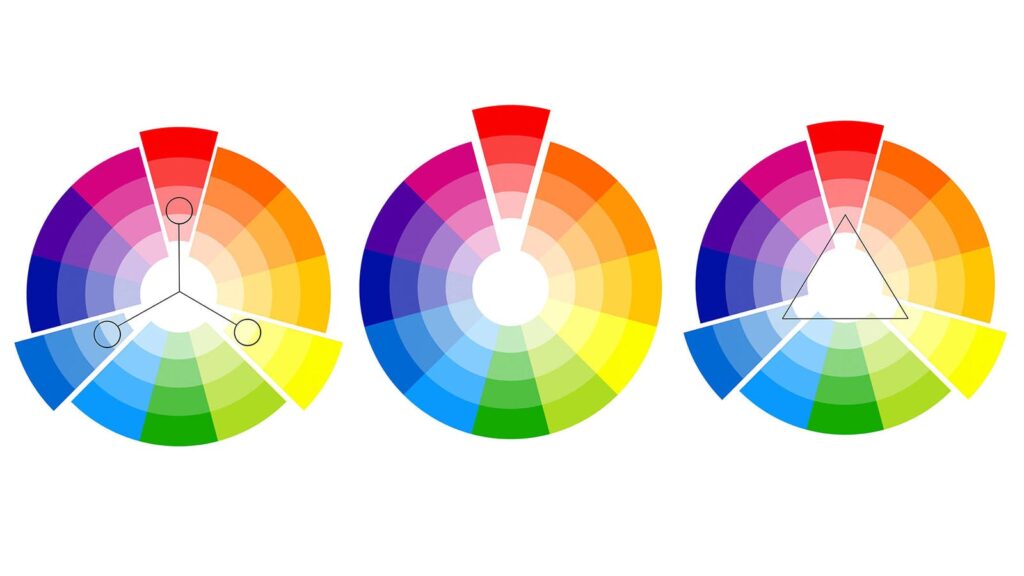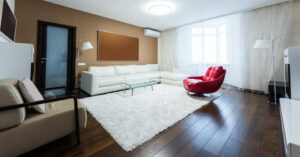
Choosing a suitable house paint colour scheme is always important, whether you buy a brand-new home or improve an existing one.
The colour scheme of your house will be a visual depiction of your way of life. Everyone should choose colours that complement their lifestyle, right?
I’ll go over the knowledge you need to acquire in this article to make the best colour schemes and that comes from our expert house painters in Perth, with almost a decade of experience painting houses of all types, small or large, simple to fancy across the greater Perth area.
In this article
Harmonious Colour Choices
Although it’s fun to experiment with colour schemes by picking colours at random when painting, depending on our personal preferences, there are some colour combinations, referred to as harmonic colour schemes, that are thought to be particularly attractive.
Two or more colours on the colour wheel that have a particular connection based on their placement and proximity to one another are considered to be in a harmonious colour scheme.
Knowing some of the most commonly used colour names is helpful before we go over the fundamentals:
1. Tint
A colour that has received a white addition to make it lighter.
2. Hue
The paint’s natural, unmixed colour as it emerges from the tube.
3. Tone
A colour that has undergone a grey addition to either lighten or darken it.
4. Shade
A hue that has been made darker by mixing with black.
The wheel of colours
A maximum of three or four colours should make up your colour scheme.

Look at a colour wheel to get a general idea of which colours go well together. The three main colours are red, blue, and yellow; they are pure hues that cannot be produced by combining other hues.
Orange, green, and purple are secondary colours made up of an equal mixture of two basic colours. Primary and secondary colours can be found in various amounts in tertiary colours.
There are four distinct categories of colour schemes:
1. Monochromatic
To avoid looking flat, a one-colour design can include a variety of that colour’s values. The use of different textures can enhance a colour scheme.
2. Complementary
These colour schemes make use of hues like blue, green, and red/orange that are in opposition to one another on the colour wheel. Usually, the outcome is colourful and lively. The best results are achieved when one colour stands out and the other acts as a contrast.
3. Triadic
Red, orange, yellow, green, and blue-violet are some examples of the three colours used in this scheme, which are equally spaced on the colour wheel. The other two can be utilised as accents. One colour can be used as the dominating colour. a
4. Analogous
This colour scheme makes use of three to five colours, one of which is one of the fundamental colours. The colour segments that appear on each side of the primary colour are analogous colours. It is advantageous to change the colour’s value and intensity.
Colour Perception
Remember these three things as you choose your colour scheme. The appearance of colours changes when
- In various lighting conditions
- Next to various hues
- Depending on the amount of the colour
Key Things to Bear in Mind
Before choosing a colour scheme, it is important to consider the size and shape of each area.
Bold colours work best in larger rooms, whereas light colours work best in smaller ones. The ideal colour scheme for your house’s paint may give it a cohesive appearance.
If you want a fresh, contemporary feel, monochromatic designs in cool colours are a terrific choice.
Space can also be made exciting by using contrasting colours as an alternative. While selecting a palette, always remember how everything will work together to create harmony from room to room.
A wonderful approach to choosing the proper paint colour scheme is to harmonise colours from room to room.
This makes picking the ideal paint colour much simpler. Visually connecting different places in your home helps establish a sense of continuity and flow.
It is frequently suggested to invest in colour schemes that coordinate throughout the house.
Pick the Right House Paint Colour Schemes
When choosing the proper colour schemes for your home, having a basic understanding of colour psychology is helpful.
Paint is more than just the outcome of the colour it is coloured, too; it also involves the technology of the paint itself, including its gloss level, composition, and additional technologies that address specific issues.
Mood-setting, environment-transforming, and, most crucially, a distinct sense of style are all possible with colour. You hold the right to your perception of the ideal colour.
Make a starting point
The essential task is to get going.
Everything you choose can serve as a starting point. You can begin with the most expensive or relatively ineffective material in the first phase.
A second way to get a project going is to pick a favourite piece of art as the inspiration. Artwork is typically viewed from a distance. So, you can take a step back and think about the colour as a whole.
The final colour you perceive is influenced by how differently furniture and artwork reflect and absorb the colour. For the finest representation of the final colour scheme, it is always recommended to evaluate colours in a completely furnished space.
Discover your inspiration
The colours and styles you plan to purchase may already be in your mind. Hence, you can start archiving images that attract your interest.
Find the common once you have a sizable collection. It will assist you in choosing the preferred colour schemes of your choice.
Be respectful of the space
You need to think about a few things before deciding on a colour scheme for a room.
What the space is used for, who uses it the most, the colour schemes of nearby rooms, the mood you want to set, and any current furniture or accessories that will be included in the final colour scheme are all important factors to consider.
Who will be using the room the most should always be taken into consideration when choosing colours.
You don’t necessarily have to incorporate a hue into your scheme just because it’s trendy.
The most important thing is what you and your family like. Homes that reflect their owners’ personalities have the nicest décor.
Lighting
To avoid disappointment, make sure to check and choose the colour in the actual lighting of the room that will be painted.
Colours may appear radically different in various light levels. Hence, in natural and artificial light, you need to consider the appropriate colour scheme.
The appropriate ratios
Variate the proportions while utilizing several colours in one design. The atmosphere will feel uneasy, and the colours will feel way too vivid when they are used in equal amounts.
You can apply the 60:30:10 rule.
For the majority of the walls, as well as potentially some furniture and a rug, the colour 60 serves as the primary accent, while the colours 30 and 10 serve as its secondary and tertiary counterparts (cushions, lamps, and accessories; it could also be a bold paint colour used on a splashback).
Neutral Paint Colours
For other colours, neutral paint colours provide a foundation. If neutral paint is on your mind, consider the undertone that corresponds to the look you want to achieve:
Consider painting your room a warm neutral colour with undertones of yellow, red, or orange for a pleasant atmosphere.
Neutrals like white and grey with cooler undertones like green, blue, or purple are a good choice if you want a more open, airy feel.
Bedroom Paint Color
Your bedroom should be painted in a colour that is more carefully considered than other rooms. It’s crucial to pick bedroom paint colours that help you fall asleep. Also, you could find yourself gazing up at the ceiling more often than you might in other rooms.
As a general guideline, stay away from using extremely vivid colours and reserve them for other areas of your house. Bedrooms are best suited to light and pastel colours. Furthermore, due to its calming qualities, blue is a popular colour option for bedrooms.
Living Room Paint Colour
You can choose between light and dark living room paint colours scheme to suit your taste. Modern living rooms typically experience less wear and tear than family rooms. Modern living rooms are frequently open areas that connect to the dining and kitchen areas. It can be challenging to decide where to begin and end the colour scheme in an open-plan area. There are two approaches you can use:
- To create a natural colour break, paint a feature area in the space between two adjacent rooms or spaces.
- Employ a sequence of colours, then use one colour as the primary colour for the entire space and the other colours as accents.
Roof Paint Color
The hue of the roof paint comes in a wide variety. It might be challenging to select the ideal roof paint colour. The colour scheme of your home and the overall effect you want to create should both be taken into account when choosing a colour for your roof paint.
You may select a grey, or you may match the colour of your walls to the tone of your roof, resulting in contrast or synergy. Create a timeless style with a large range of hues at your disposal.
Teenage Room Paint Colour
It can be difficult to decide on a teenager’s room paint colour. Most of the time, you want your kids to have some creative influence on their surroundings, but you also need their colour choice to go with the rest of your house. The colour scheme you choose for a teen’s room should correspond to the mood they want to create there.
Neutral colours like grey, white, or beige are a safe bet. Colour schemes in homes are typically matched by neutral hues. Also, the neutrality lets you add vibrant decor, bedding, furniture, and picture frames.
Step 1: Find some inspiration.
Step 2: Examine the current colour palette.
Step 3: Choose a mood.
Step 4: Choose a saturated colour and a harmonious colour.
Step 5: Choose Your Neutrals.
Red, blue, and yellow are primary colours that cannot be made by mixing other hues. Brown results from combining them all. But if you combine them, you can get all the other hues. The darkness, brightness, or colour values of colour is also part of the colour theory.
Placing paint samples and fabric in your home and observing how they vary throughout the day and into the evening will help you test your colour choices because different lighting will affect how a colour appears. The colours of a house are truest in daylight; however, they will shift as the seasons and the light change.
You can achieve a seamless flow throughout your home, whether you prefer neutrals or brights, quiet or drama, by utilising complementary colours in neighbouring areas and by sticking to your selected colour scheme throughout your entire house.
It doesn’t have to be difficult to choose colour schemes for your house. Take your time, trust your gut, and, in the worst-case scenario, contact Perth’s house painters.








